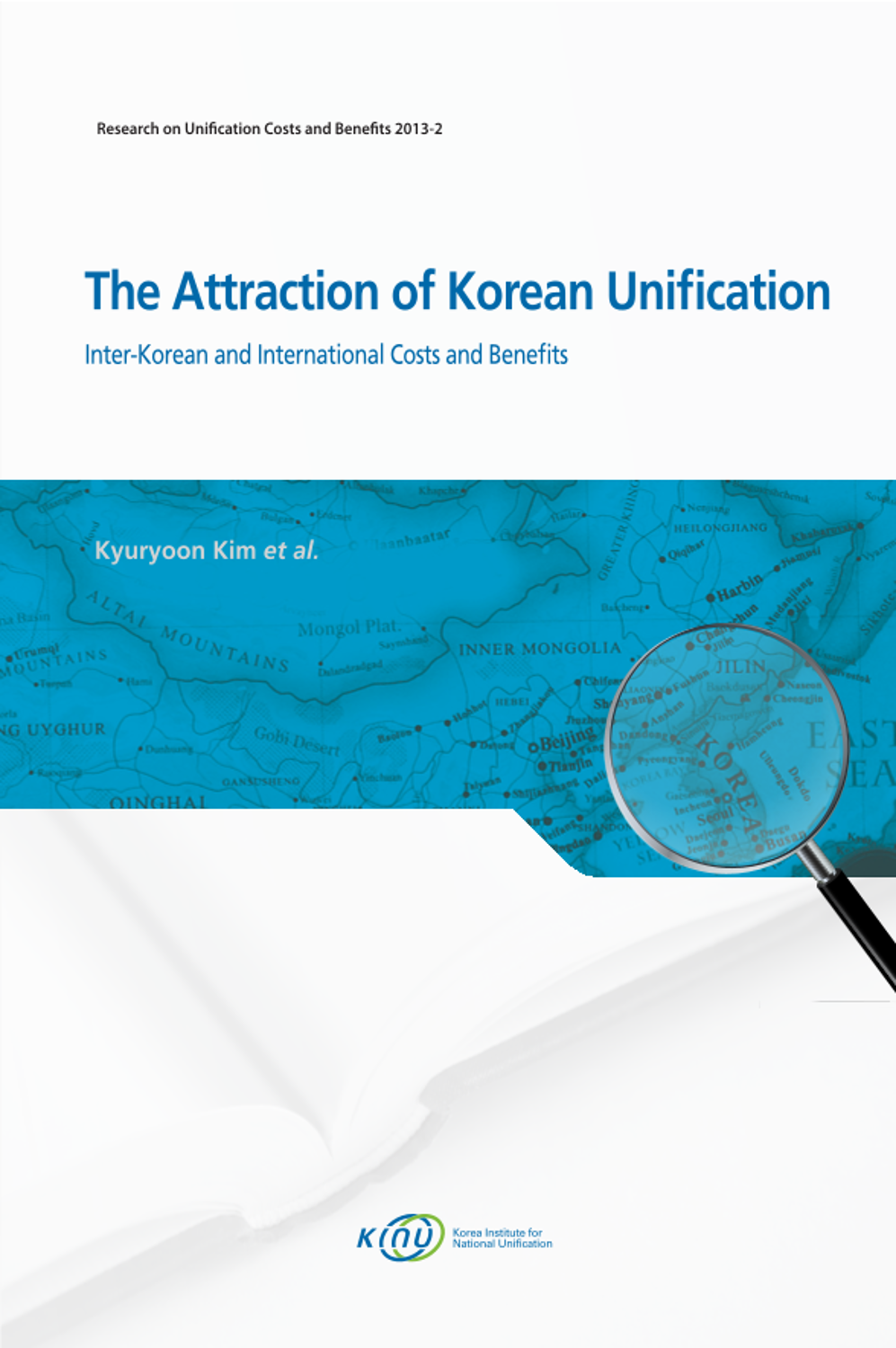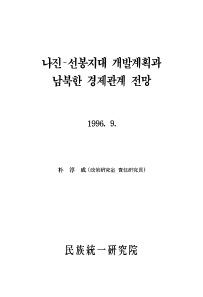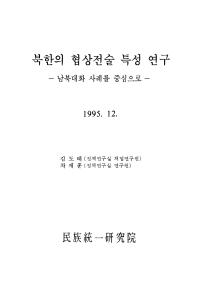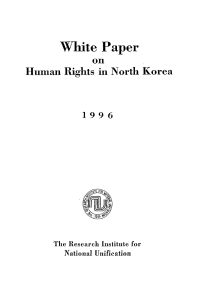
연구원발간물Research on Unification Costs and Benefits 2013-2
The Attraction of Korean Unification: Inter-Korean and International Costs and Benefits
- 발행사항
- Seoul: Korea Institute for National Unification, 2013
- 형태사항
- 337 p. : 23 cm
- ISBN
- 9788984797512
- 청구기호
- 000 비용13-2
소장정보
| 위치 | 등록번호 | 청구기호 / 출력 | 상태 | 반납예정일 |
|---|---|---|---|---|
이용 가능 (2) | ||||
| 1자료실 | G0015185 | 대출가능 | - | |
| 1자료실 | G0015186 | 대출가능 | - | |
이용 가능 (2)
- 등록번호
- G0015185
- 상태/반납예정일
- 대출가능
- -
- 위치/청구기호(출력)
- 1자료실
- 등록번호
- G0015186
- 상태/반납예정일
- 대출가능
- -
- 위치/청구기호(출력)
- 1자료실
책 소개
In purposes to overcome the negative publicity toward the Korean unification and to provide a more feasible and practical unification preparation, the Korea Institute for National Unification has conducted a five-year research project to build a comprehensive architecture for the unification costs and benefits. The project, through several brainstorming sessionxxxxxxxxxxxxxxxxxxxxxxxxxxxxs and seminars with a variety of experts, has developed a scenario and a model: the Guiding Type of Unification and the Three-Stage-Three-Area Costs and Benefits Model. The Guiding type scenario suggests a gradual and asymmetrical unification process that describes a South Korea-led unification under an agreement by all parties, including South and North Korea and the international community. The Three-Stage-Three-Area Costs and Benefits Model is an analytical tool to reveal and examine major factors of the process.
For the first time in this area of research, the model includes political and social areas. It divides the unification and integration process into three stages - Division Dissolving, System Integration and Nation Building. For the third phase of the five-year project, this study expands its focus to international research cooperation: A quantitative model-based approach to the economic changes in the Korean peninsula, and the costs and benefits of the Korean unification for neighboring powers. Accordingly, this book consists of three major parts: first, Chapters I and Ⅱ briefly review our scenario and analytic model. The structure and process of unification depicted in these chapters function as the basic premises and assumptions of the studies in the following inter-Korean and international dimensions chapters. Second, Part 1 calculates the major macroeconomic unification variables using a general equilibrium model. The study adopts the dynamic stochastic general equilibrium (DSGE) model because the model is a proper device to estimate overall costs and benefits during the unification process. Especially, it captures the developments of various economic values by year during unification process.
The DSGE model covers three main periods: the Unification Preparation period (2014-2028), the Unification Process period (2028-2050), and the Unified Nation period (2050-2060). The Unification Process period is again divided into the Division Dissolving stage (2028-2030), the System Integration stage (2031-2040), and the Nation Building stage (2041-2050).
During the two-year Division Dissolving stage, South Koreans pay an extra 0.5% tax on their income, while the North gets a big boost to consumption by 37%. A dramatic growth begins after the System Integration stage. North Korean GDP and wages increase by 10 times, while consumption rises by 13 times over the decade between 2030-2040 period. Since the gains from free markets and trade are not a zero sum, South Korea would continue its steady growth even while providing the North with massive aid, and opening up labor and capital flows between the two sides. The model implies that Southern part’s GDP, consumption, and wages would grow by a solid 1-2% per year in real terms. The pattern of rapid growth in the North and steady growth in the South continues during the Nation Building stage.
Throughout the unification process, Northern part completely transforms from one of the most impoverished to one that achieves middle class status. All indicators of North Korea increase more than 25 times, Icluding GDP, consumption, and wages. Its private capital stock would also strengthen, increasing more than 15 times in value. These gains are made possible in large part because of substantial aid from the South, but it continues to experience steady growth, even after that aid ends. The levels of GDP, consumption, wages and private capital do not actually drop in the South, but steadily grow. The South will enjoy the fruits of its investments in the North.
Part 2 analyzes the costs and benefits of the four powers during the unification process. The future of the Korea-U.S. relation is the biggest concern for both the U.S. and China. It has a huge impact on whether each side perceives unification as a cost or benefit. For the U.S., vulnerable alliance with Korea and the relocation of the U.S. troops in the South during the unification process would be a cost, while China worries about bordering with Korea or the U.S.-Korea alliance after losing its long-time buffer zone, North Korea.
All four powers expect that the Korean unification would lessen the security vulnerability caused by the North Korean regime. This would be one of the biggest benefit to them. They all agree that controlling and finally dismantling WMD from the Korean Peninsula would be a great benefit. Even China perceives North Korean WMD as a cost, especially after the third nuclear test by North Korea, and it will continue to benefit from WMD control over all unification stages. Russia also wants to end the instability in the Northeast Asia, so the economy of the Russian Far East can prosper. During the System Integration and Nation Building stages, a unified Korea would socially and economically be benefit both the Far East and Northern areas. In Japan’s case, finding solutions of the Japanese abductee issues is the highest priority.
In sum, this study could be useful for the policy makers in Korea and the neighboring four powers. It should also be noted here that the efforts for achieving the unification were begun when the Korea were divided against its will by the international arrangements. It is necessary for the two Koreas and international actors to continue making every effort to solve the problems stemming from the division of the Korean peninsula in a peaceful manner.
목차
Preface
Abstract
Introduction
Ⅰ. Guiding Type of Unification
Ⅱ. Three-Stage-Three-Area Costs and Benefits Model
Part 1. Costs and Benefits of Korean Unification: Inter-Korean Dimension
Ⅲ. Overview of the Economic Model
Ⅳ. Economic Effects of the Unification Preparation Period and the Division Dissolving Stage
Ⅴ. Economic Effects of the System Integration Stage
Ⅵ. Economic Effects of the Nation Building Stage and the Unified Nation Period
Ⅶ. Summary of Economic Effects over All Stages
Part 2. Costs and Benefits of Korean Unification: International Dimension
Ⅷ. The Costs and Benefits of Korean Unification for the United States
Ⅸ. The Costs and Benefits of Korean Unification for China
Ⅹ. The Costs and Benefits of Korean Unification for Russia
?. The Costs and Benefits of Korean Unification for Japan
Conclusion
?. Summary of Research Findings
XIII. Policy Considerations
References




